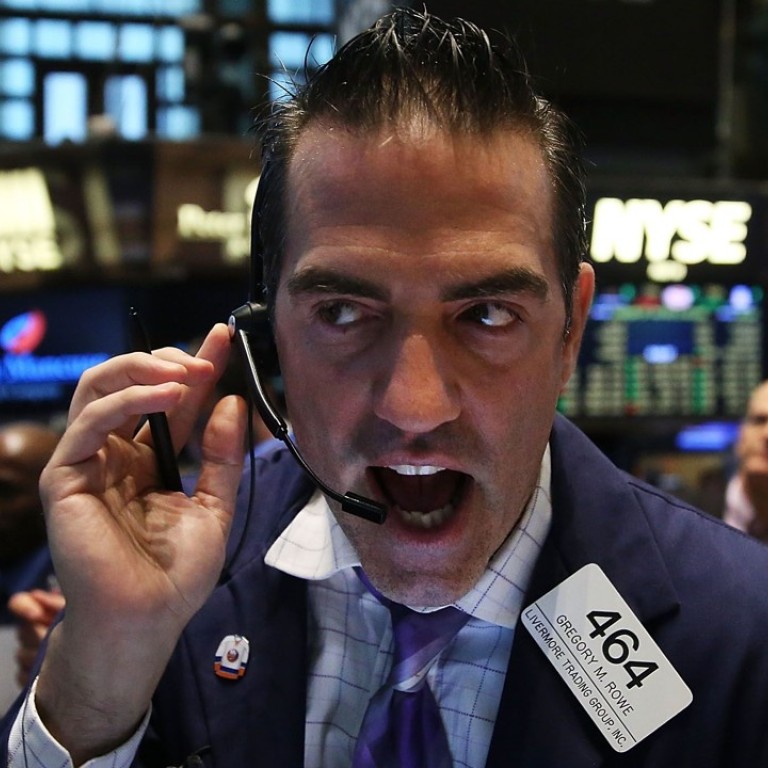
Return of market volatility leaves investors dazed and confused
What’s clear is the bears are starting to give the bulls a run for their money, as the recent surge in volatility attests
One of the most popular expressions among traders and investors is “the trend is your friend.”
The maxim refers to the importance of historical and long-term movements in asset prices which are often associated with correlations between asset classes, such as the relationship between government bonds and currencies.
The recent eruption in volatility in financial markets, in which a staggering US$5 trillion was wiped off the value of global equities in a two-week period as the VIX Index – Wall Street’s “fear gauge” – briefly rose to its highest level since China’s surprise devaluation of the yuan in August 2015, has shown that some of the most established trends can be distinctly unfriendly.
In one of the most striking developments in markets in recent years, the US dollar has continued to decline despite the surge in the yield on 10-year Treasury bonds and the increase in inflationary pressures – the initial catalysts for the recent sell-off.
Last week, the dollar index, a measure of the currency’s performance against a basket of its peers, dropped a further 1.4 per cent, extending its decline since the start of this year to 3.3 per cent.
The greenback’s failure to respond to a rise in the benchmark Treasury yield to just below the psychologically important level of 3 per cent and an inflation threat that increases the risk of a more aggressive tightening in US monetary policy is the clearest sign yet that long-standing correlations in markets have broken down.
On a broader level, it is also a reflection of the disorientation and conflicting narratives which have become much more pronounced since volatility returned earlier this month. The journey from nearly a decade of ultra-loose monetary policy to more normal financial conditions has suddenly become a lot bumpier, leaving investors dazed and confused.
In one of the most striking developments in markets in recent years, the US dollar has continued to decline despite the surge in the yield on 10-year Treasury bonds and the increase in inflationary pressures – the initial catalysts for the recent sell-off
While 2017 was an exceptionally tranquil year, fuelling a bull market in bonds and equities, 2018 is shaping up to be a much more turbulent year in which markets will struggle to establish a clear direction and consensus trades will be hard to come by.
In all the main asset classes, confusion and contradictions reign.
After suffering one of its worst weeks since the global financial crisis earlier this month, the benchmark S&P 500 equity index quickly roared back, gaining 4.3 per cent last week, its strongest performance since early 2013 and leaving the index only 5 per cent below its record high reached on January 26.
What’s more, despite the clear threat posed by the rise in bond yields, US companies with the weakest balance sheets outperformed the broader equity market last week, enjoying their best weekly advance in five years, according to data from Bloomberg.
This is all the more striking given that high-yield, or “junk”, bond funds suffered their second-largest outflows on record last week, driven by concerns about inflation and tighter monetary policy.
Make no mistake, markets are suffering from multiple-personality disorder in which conventional correlations and clean narratives have given way to volatile and conflicting movements in asset prices.
The market narrative that makes the most sense right now, however, and the one which I touched on in a previous column is that international investors are increasingly unsure whether stronger growth, particularly in the US, is a good or bad thing.
One of the reasons stock markets bounced back so quickly is because of the continued optimism surrounding the global economy. The publication of a closely watched economic survey carried out in the same week that equity markets were plunging showed that US consumer confidence has shot up to its second-highest level since 2004, buoyed by tax cuts and signs of stronger wage growth.
This is the narrative that the bulls are seizing on, and the one that, for the time being, has the upper hand.
The bears are focusing on the flip side of buoyant growth: the threat posed by a sharper rise in inflation and higher bond yields.
This tug of war in markets could persist for a considerable time to come as investors question the extent of the threat posed by rising inflation and, more importantly, whether the Federal Reserve, under its new chairman Jerome Powell, will move aggressively against a sharper increase in consumer prices.
What is clear, is the bears are starting to give the bulls a run for their money, as the recent surge in volatility attests.
Both camps, however, will struggle to navigate markets in the weeks and months ahead as the journey from quantitative easing to tighter monetary conditions gets bumpier and bumpier.
Nicholas Spiro is a partner at Lauressa Advisory

